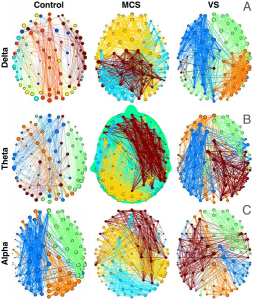Oct 17 2014
Brain Activity in Vegetative Patients
 A vegetative state is a particular kind of coma in which patients appear to be awake but give no signs (by definition) of any awareness. They do not respond to their environment in any way or do anything purposeful. Some patients display a flicker of awareness, and they are categorized as minimally conscious.
A vegetative state is a particular kind of coma in which patients appear to be awake but give no signs (by definition) of any awareness. They do not respond to their environment in any way or do anything purposeful. Some patients display a flicker of awareness, and they are categorized as minimally conscious.
Neuroscientists have been using the latest technology to look at brain function in vegetative subjects and comparing that function to healthy controls. In this way they hope to gain insight into the neurological correlates of consciousness – what brain activity is necessary for and responsible for conscious awareness. A new study, published in PLOS Computational Biology, replicates this research with interesting findings.
As with previous studies, the researchers found that the majority of vegetative patients had profound abnormalities of brain function compared to healthy controls. They found:
Here, we apply graph theory to compare key signatures of such networks in high-density electroencephalographic data from 32 patients with chronic disorders of consciousness, against normative data from healthy controls. Based on connectivity within canonical frequency bands, we found that patient networks had reduced local and global efficiency, and fewer hubs in the alpha band.
This means they measured the electrical activity of the brain and found that patients in a vegetative or minimally conscious state had decreased brain activity. A healthy brain has massive local and global networks of neurons exchanging information across the brain. The brains of patients with impaired consciousness had markedly reduced activity and fewer hubs of activity.
This makes sense. Conscious awareness seems to be a distributed function of the brain, and the brain has to have a certain threshold of activity in order to maintain wakefulness and awareness. If that activity is reduced the result is unconsciousness. If that activity is reduced by damage to the brain, the result is long-term or permanent unconsciousness, or coma. The study failed to show a tight correlation between the amount of activity and the relative degree of behavioral function in the subjects, but this could be due to the small sample size and the small differences among subjects.
However, this study (also in line with previous studies) found that in a minority of subjects, four of those studied, the network activity in the brain was similar to healthy controls (although not normal). They had much more robust activity than the other subjects with impaired consciousness.
Further, the authors performed another test that has been published before. They imaged brain activity with fMRI scanning and asked subjects to imagine themselves playing tennis. In conscious patients this results in a pattern of activity reflecting motor planning. The four comatose patients with robust brain activity showed motor planning activity when given the tennis test.
To summarize these results – four subjects who appear to be in a vegetative state by neurological exam, showed fairly robust brain activity on EEG and responded to the tennis test as measured by fMRI activity. The big question is, what is going on in the brains of these four subjects? The authors write:
Overall, our research highlights distinctive network signatures of pathological unconsciousness, which could improve clinical assessment and help identify patients who are aware despite being uncommunicative.
In other words, these four patients, and patients like them identified in other studies, may have some conscious awareness but we simply cannot detect that awareness because of more focal deficits, such as paralysis. This would make them more in line with locked-in patients rather than vegetative patients.
I think, however, we are not yet able to draw that conclusion from the data we have (to be fair, the authors do not draw that conclusion, but they do imply it, and that is the one point the press is focusing on). It is very possible that conscious awareness requires robust local and global brain communication, but also requires some specific activity in the brain. There may be some critical networks without which awareness is impaired. In a subset of patients, overall brain activity may be preserved, but the critical networks are damaged and so awareness is impaired.
Although not part of the current study, previous studies compared patients who were vegetative from diffuse processes such as anoxia (lack of oxygen) and those whose brains were damaged by trauma. The trauma patients may have some parts of the brain that are damaged and others that are undamaged. These trauma patients are the ones who are more likely to have the more robust brain activity despite being vegetative or minimally conscious, whereas the diffuse anoxia patients rarely if ever fall into this category. The question remains – are the focal areas of damage inhibiting awareness or just inhibiting motor and sensory function?
At this point the bottom line is that we just don’t know. Both of these possibilities may also be true for different patients. Every permutation likely exists, and researchers are simply sorting out which permutations are possible.
I am not yet convinced that it is possible patients who appear to be vegetative are actually aware and therefore really locked in. These would have to be very special cases, with just the right assortment of deficits to keep them from displaying any signs of their consciousness. I think it is more likely that the subset of patients with relatively preserved brain activity while being in a coma simply have focal damage that is impairing circuits critical to conscious awareness.
We will see. This is a fascinating area of research, and we are making steady progress. Researchers are making better and better use of existing technology, and that technology itself is progressing.






